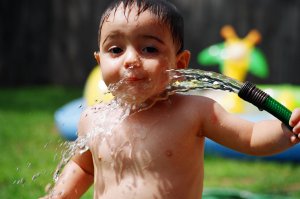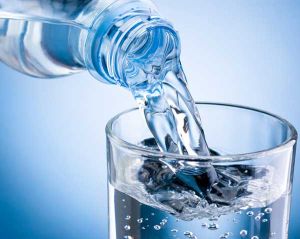

Contaminants in Your Bottled Water
by Environmental Working Group
 In the ten bottled water brands tested, thirty-eight different contaminates were found by the public health activist group Environmental Working Group. Two brands (Wal-mart's Sam's Choice and Giant Food's Acadia) violated state and industry standards.
In the ten bottled water brands tested, thirty-eight different contaminates were found by the public health activist group Environmental Working Group. Two brands (Wal-mart's Sam's Choice and Giant Food's Acadia) violated state and industry standards.
Consumer watchdog organization Environmental Working Group, headquartered in Washington, D.C., stated within an October 15, 2008, New York Times article, that it found a "surprising array of chemical contaminants." [The New York Times: "A New Dig at Bottled Water"]
As reported by the EWG, some of the chemical contaminants included chlorination byproducts, bacteria, caffeine, acetaminophen (pain reliever), solvents, plastic-making chemicals, strontium (radioactive element), and fertilizer residue. {EWG: "Bottled Water Quality Investigation: 10 Major Brands, 38 Pollutants"]
The EWG researchers stated that some of the contaminants came from the tap water used by the bottled water companies, while other contaminants came from the plastic water bottles.
The water tested by the EWG researchers was purchased in nine states and the District of Columbia.
They stated that eight of the ten brands did not have sufficient amounts of contaminants to make further tests. However, they stated that two brands did have higher amounts of contaminants.
Therefore, they further tested these two brands: Sam?s Choice (which is sold by Wal-Mart) and Acadia (sold by Giant Foods)
What was the worst found pollutant with respect to its concentration? Please read page two.
According to the AP article, the worst bottled water concerning the highest concentration of chlorine byproducts (trihalomethanes) was 35 parts per billion (ppb). [Associated Press: "Bottled water has contaminants too, study finds"]
That concentration was in both Sam?s Choice and Acadia. The report stated that the limit in the state of California for that chemical is 10 ppb, the IBWA limit is also 10 ppb, and the federal limit is 80 ppb.
Therefore, according to the EWG, these brands violated the California state and IBWA limit, but was within the limit for the U.S. government.
Giant Foods stated that its Acadia brand meets all regulatory standards. And Wal-mart stated its Sam?s Choice brand had in the past shown no "reportable amounts" of such contaminants when it was tested by the company. [AP]
The New York Times reports that the International Bottled Water Association (IBWA) called the accusations "alarmist" and sensationalized science."
Joe Doss, president of the IBWA, stated, "In general, the report is based on the faulty premise that if any substance is present in a bottled water product, even if it does not exceed the established regulatory limit or no standard has been set, then it?s a health concern." [New York Times]
 If the New York Times is reporting this story accurately, and I am assuming it is, the Times author has stated "that contaminant levels in some water samples exceeded the industry?s own voluntary standards. Further, the group said, levels of contaminants found in bottles of Sam?s Choice water--a Wal-Mart brand--that were purchased in California exceeded that state?s standards."
If the New York Times is reporting this story accurately, and I am assuming it is, the Times author has stated "that contaminant levels in some water samples exceeded the industry?s own voluntary standards. Further, the group said, levels of contaminants found in bottles of Sam?s Choice water--a Wal-Mart brand--that were purchased in California exceeded that state?s standards."
So, Mr. Doss? statement that the report is faulty because it is reporting the presence of contaminates "even if it does not exceed the established regulatory limit" is itself wrong because some of the contaminants DO exceed the industry or state limits.
In defense of Mr. Doss' statement, he is correct in his statement that none of the found contaminants exceeded the federal limits. [Associated Press: "Bottled water has contaminants too, study finds"]
According to the AP article, "...all the brands met federal health standards for drinking water. Two violated a California state standard, the study said."
U.S. environmental engineer Jane Houlihan, who co-authored the study, stated, "In some cases, it appears bottled water is no less polluted than tap water and, at 1,900 times the cost, consumers should expect better." [AP]
This is only one report on the quality of bottled water. However, many previous reports have concluded similar to this EWG report.
It is becoming apparent, at least to me, that bottled water is not necessarily better than tap water. And, as stated earlier, bottled water costs thousands of times more than tap water. In fact, at work, in restaurants, and in public buildings tap water doesn?t cost anything?it?s free.
In addition, when consumers throw away the plastic bottles after one use, they are adding to environmental pollution of our world. If consumers do drink bottled water from plastic bottles, please recycle the plastic so it can be re-used rather than remain in landfills decaying for hundreds of years.
And, in my opinion, it doesn't help the consumer when one side says "everything is fine--no problem" and the othe side says, "we have a problem." Both sides need to get together and either solve the problem or decide there is no problem.
In this case, do another coordinated study with all of the researchers from the EWG, the IBWA, Wal-mart, and Giant Foods, and find out what is going on with these bottled waters. Get the facts, state them to the public, correct any problems found, and get on with things. Just do it!